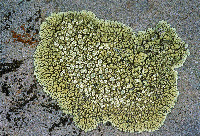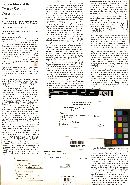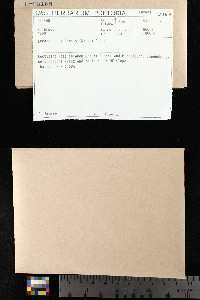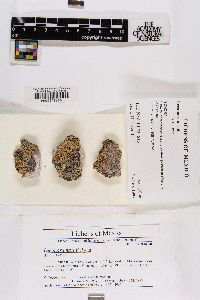
Consortium of Lichen Herbaria
- building a Global Consortium of Bryophytes and Lichens as keystones of cryptobiotic communities -
- Home
- Search
- Images
- Species Checklists
- US States: O-Z >
- US National Parks
- Central America
- South America
- US National Parks
- Southern Subpolar Region
|
|
|
|
Family: Lecanoraceae
|
Nash, T.H., Ryan, B.D., Gries, C., Bungartz, F., (eds.) 2004. Lichen Flora of the Greater Sonoran Desert Region. Vol 2. Thallus: placodioid, areolate to rosulate, usually forming distinct rosettes or low mounds 0.5-2.5 cm wide, but sometimes scattered or irregular in outline, tightly to often somewhat loosely adnate, 0.2-0.5(-1.5) mm thick; prothallus: absent or vestigial and black areoles: +isodiametric, angular, 0.5-1 mm wide, mostly contiguous but discrete, flat to undulating, +square-edged, usually slightly constricted at base lobes: weakly to occasionally distinctly elongated, 1-2(-4) mm long, 0.5-1.5(-2) mm wide, partly rather coarsely crenate-incised into segments 0.3-0.5 mm wide, discrete to contiguous, plane to concave; edges: often raised and thickened into rims upper surface: various shades of yellow with an orangish or brownish cast, especially where parasitized (in herbarium soon yellow to orange-brown), smooth, continuous to strongly rimulose, dull to slightly shiny, usually epruinose, esorediate thallospores: usually present on edges, black, 5-6 µm in diam. upper cortex: with dead algal cells (sometimes few), 25-50 µm thick, inspersed with granules especially in upper part; hyphae: randomly oriented, c. 5 µm wide, thin-walled; lumina: rounded to anticlinally elongated, 3-7 µm long, 2-3 µm wide; epinecral layer: 10-25 µm thick medulla: smooth or covered with granules (insoluble in K), on lower edge protruding, becoming olive-brown or green-black; hyphae: 3-5(-7) µm in diam.; algal layer: c. 40 µm thick, continuous or somewhat interrupted lower surface: pale brown or blackening towards edges, appearing fibrous lower cortex: absent Apothecia: occasional to numerous but not crowded, 1-2 per areole, immersed to adnate, finally sessile and slightly constricted, 0.3-1.5(-2.5) mm across disc: weakly to strongly yellow (under pruina dark grayish olive to moderate yellow, orange or brown), plane to slightly concave, pruinose; pruina: appearing light or pale orange-yellow, grayish green-yellow or pale yellowish green margin: concolorous with thallus to slightly paler; at first usually blending into the thallus, then often flat-topped or very low and sloping, 0.1-0.2(-0.5) mm wide, even with disc or slightly raised, entire and rounded to flexuous or cracked-crenate, outer edge sometimes becoming blackened and granular, with thallospores, without a parathecial ring amphithecium: present, with a continuous or interrupted algal layer (30-50 µm thick) extending below the hypothecium, with a medulla similar to that of thallus, corticate; cortex: overall (30-)60-75 µm thick, the outer (20-)35-40 µm inspersed with granules (soluble in K but insoluble in N) parathecium: hyaline, indistinctly to somewhat distinctly delimited, c. 30 µm thick, with randomly oriented hyphae (1.5-2.5(-3) µm in diam. and with rounded to mostly somewhat elongated lumina c. 1 µm wide) or hyphae +anticlinal to the disc epihymenium: with superficial granules soluble in K, c. 10 µm thick hymenium: sometimes appearing orange-red in thick section, 50-70 µm tall; paraphyses: loosely coherent; tips: hyaline (to olive, and then K+ pale green, N+ pale red), clavate, 2-3 µm wide; subhymenium: hyaline to slightly gray-brown, 30-50 µm thick, without oil drops; hypothecium: up to 100(-200) µm thick in center asci: clavate, 8-spored ascospores: hyaline, simple, mostly ellipsoid to broadly ellipsoid or ovoid, (8-)10-12(-14) x (4-)5-7(-9) µm Pycnidia: immersed; ostioles: dark; conidiophores: type III of Vobis (1980) conidia: (15-)25-35(-45) µm long Spot tests: thallus K- or occasionally K+, C-; cortex KC+ yellow, P-; medulla KC-, P+ yellow or less often P- Secondary metabolites: cortex with usnic acid major; medulla with psoromic acid, or sometimes fatty acids (murolic acid complex), unknowns, or no substances. Substrate and ecology: usually on siliceous rocks (conglomerate, granite, rhyolite, sandstone, schist, volcanic rocks including basalt and pumice), sometimes exposed to calcareous dust, rarely on limestone; on steep to gentle, shaded to exposed surfaces, in woodland areas (oak, oak-pine-manzanita, juniper-oak-cholla) or thorn forest (Acacia, Fouquieria, Lycium, Prosopis), less often Sonoran Desert cactus communities or scrub (agave, cholla, cordón, jojoba, Larrea, Machaeocereus, ocotillo, palo verde, saguaro, yucca), occasionally in grassland World distribution: SW N. America (E to New Mexico, SW Colorado, Texas, and Coahuila, S to south-central Mexico) Sonoran distribution: Arizona (3052775 m), Chihuahua (1360-1830 m), Sonora (365-1280 m), Baja California Sur (500-1300 m). Notes: Although Lecanora nashii was previously described by de Lesdain (1914), as a variety of Squamaria saxicola (= Lecanora muralis), the name Lecanora flavida Hepp, Flecht. Eur.: nr. 630 (1860) was published for the species now known as Eiglera flavida (Hepp) Hafellner, and at any rate the name nashii has priority over flavida de Lesd. at the species level. The isotype of S. saxicola var. flavida differs somewhat from typical L. nashii in that the thallus is more scattered, the lobes smaller, thinner and more finely incised, with edges only weakly thickened and blackened, and the apothecia smaller, with thinner margins; however, this morph also occurs in Sonora. It is distinguished from L. bipruinosa, by 1) thallus surface at least slightly more yellow or brown (especially where parasitized) and usually epruinose; 2) lobes mostly short and little divided, and rather thick; 3) edges areoles mostly thickened, with thallospores; 4) apothecia often remaining immersed to adnate; 5) parathecium cell lumina all narrow and elongated; 6) spores usually more broadly ellipsoid; 7) partly different distribution and ecology. However, both taxa are extremely variable, and are sometimes difficult without seeing both together, especially in lowland areas and on calcium-containing or -influenced rock. Material from Baja California Sur is almost always P- and tends to have few or no thallospores, rather broad, convex lobes and gently sloping apothecial margins; it may represent a separate subspecies. |
Powered by Symbiota















